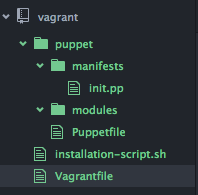Installing Puppet Modules – Librarian Puppet
Of course we can manually download the modules from Puppet Forge and install it but it becomes messy as you have to manually maintain the dependencies between the modules which definitely makes your repository bigger than necessary.
Already I briefed about librarian-puppet in my Blog At Xebia, still to provide little more context, it manages the Puppet modules your infrastructure depends on, whether the modules come from the Puppet Forge, Git repositories or just a path. People who are familiar with Maven can relate librarian-puppet similar to it as it automatically download and manage dependent modules.
In this article we will learn how to install arpitaggarwal/tomcat Puppet Module using librarian-puppet. The complete source code is hosted on github.
Step 1: Create a directory with any name for me it’s vagrant, as follows:
$ mkdir vagrant $ cd vagrant $ vagrant init
Step 2: Edit the Vagrantfile with below content:
VAGRANTFILE_API_VERSION = "2" Vagrant.configure(VAGRANTFILE_API_VERSION) do |config| config.vm.box = "hashicorp/precise32" config.vm.network :private_network, ip: "90.0.9.99" config.vm.provision "shell", path: "installation-script.sh" config.vm.provision :puppet do |puppet| puppet.manifests_path = 'puppet/manifests' puppet.module_path = 'puppet/modules' puppet.manifest_file ="init.pp" end end
Step 3: Create installation-script.sh in your current project directory(vagrant), which will install, librarian-puppet, it’s dependency GIT and Puppet in your guest machine, as follows:
$ touch installation-script.sh
Content of installation-script.sh should look something like this:
#!/usr/bin/env bash set -e # Directory in which PuppetFile is placed to be scanned by librarian-puppet. PUPPET_DIR=/vagrant/puppet echo "Installing Git.." apt-get -q -y install git echo "Installing librarian-puppet.." if [ "$(gem search -i librarian-puppet)" = "false" ]; then RUBY_VERSION=$(ruby -e 'print RUBY_VERSION') case "$RUBY_VERSION" in 1.8.*) # For ruby 1.8.x librarian-puppet needs to use 'highline' 1.6.x # highline >= 1.7.0 requires ruby >= 1.9.3 gem install highline --version "~>1.6.0" > /dev/null 2>&1 # Install the most recent 1.x.x version, but not 2.x.x which needs Ruby 1.9 gem install librarian-puppet --version "~>1" ;; *) gem install librarian-puppet ;; esac fi echo "librarian-puppet installed!" echo "Executing PuppetFile.." cd $PUPPET_DIR && librarian-puppet install --path modules echo "Installing Puppet repo for Ubuntu 12.04 LTS" wget -qO /tmp/puppetlabs-release-precise.deb \ https://apt.puppetlabs.com/puppetlabs-release-precise.deb dpkg -i /tmp/puppetlabs-release-precise.deb rm /tmp/puppetlabs-release-precise.deb aptitude update echo Installing puppet aptitude install -y puppet echo "Puppet installed!"
Step 4: Make directory puppet and then modules and manifests under it, as follows:
$ mkdir puppet $ cd puppet/ $ touch Puppetfile $ mkdir modules $ mkdir manifests $ cd manifests $ touch init.pp
Content of Puppetfile should look like:
forge "http://forge.puppetlabs.com" mod "arpitaggarwal/tomcat"
Content of puppet/manifests/init.pp should look like:
class { 'tomcat': }After performing all the above steps, your project structure should look like as:
Step 6: Now you can boot up your VM provisioned with Tomcat from the vagrant directory executing command:
$ vagrant up
That’s all. Happy Learning!
| Reference: | Installing Puppet Modules – Librarian Puppet from our SCG partner Arpit Aggarwal at the Arpit Aggarwal blog. |




